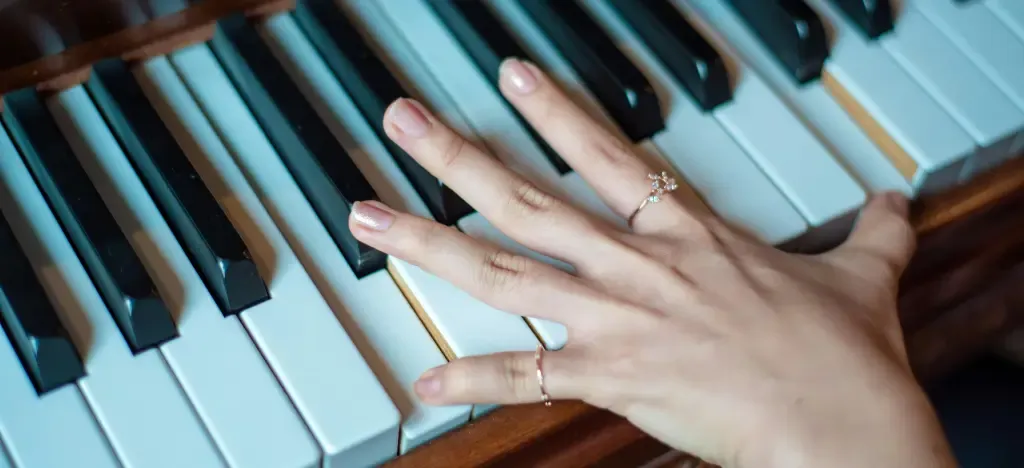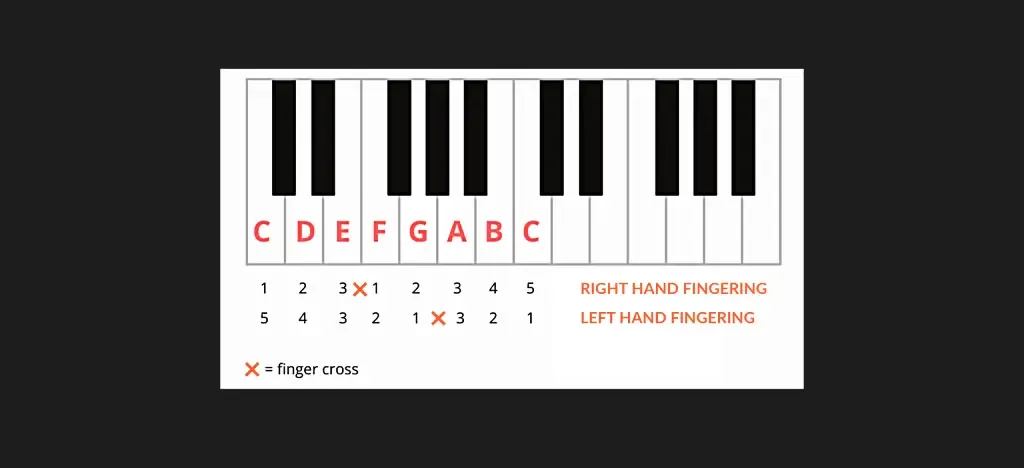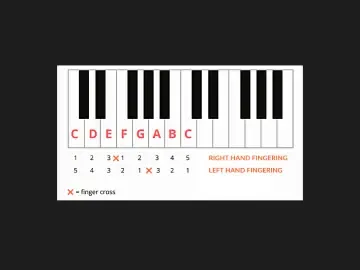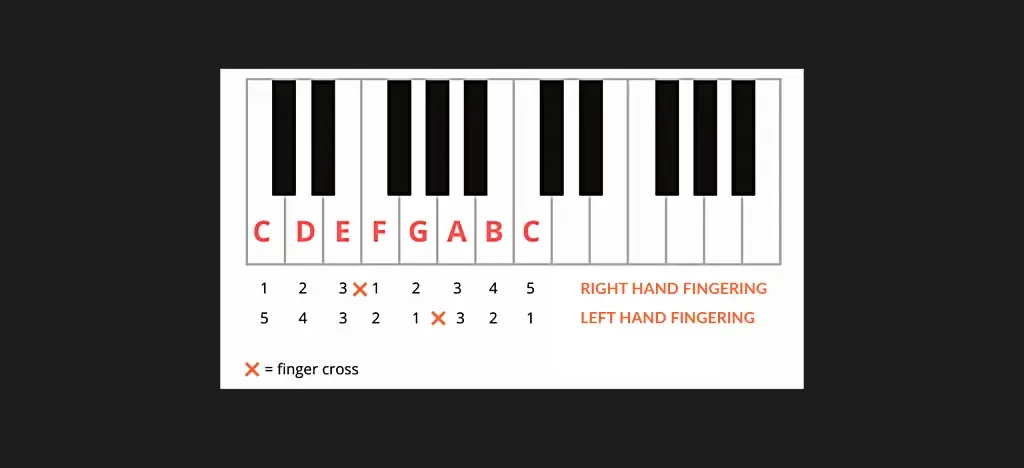If you're learning piano, you've probably heard the same advice over and over again: “Just practise your scales.” And if you're anything like me when I started, that probably made your heart sink a little.
Scales? Really?
But here’s the thing I eventually realised: practising scales is one of the quickest ways to feel more in control at the piano. Your hands get stronger, your fingers know where they’re going, and music starts to make more sense. It doesn’t have to be boring — and it doesn’t have to take hours a day.
Here’s a beginner-friendly guide to what piano scales are, why they’re useful, and how to start learning them the smart way.
- What exactly is a piano scale?
- Why beginners should care about scales
- Free video lesson: What is a major scale?
- The first scale you should learn: C Major
- How to build your own major scale: the T–T–S–T–T–T–S formula
- Minor scales: the emotional cousin of the major scale
- Scale practice tips for beginners
- How to keep improving on piano as a beginner
- FAQ: Piano Scales for Beginners
What exactly is a piano scale?
 A scale is just a sequence of notes played in order, either going up (ascending) or down (descending). The most common type is the major scale, which has a bright, happy sound. You’ll also come across minor scales, which sound more emotional or darker.
A scale is just a sequence of notes played in order, either going up (ascending) or down (descending). The most common type is the major scale, which has a bright, happy sound. You’ll also come across minor scales, which sound more emotional or darker.
Scales usually have eight notes, starting and ending on the same note, one octave apart — like C to C, or G to G.
You can play scales with one hand, or both. You can play one octave or several. And over time, they become a kind of musical map — one that helps you find chords, improvise melodies, and understand the key of a song.
💡 ARTMASTER TIP: Just getting started with piano? Make sure you've got the basics covered — from posture to hand position and simple melodies. Read our easy guide for beginners.
 💡 Real feedback. Real progress. Meet Artie.
💡 Real feedback. Real progress. Meet Artie.
Artie is the world’s first AI piano teacher that actually listens to your playing and gives real-time feedback to help you improve faster.
Want early access? Join the waitlist and be among the first to try Artie when it launches.
Sign up now for early access
Why beginners should care about scales
It’s easy to think, “I just want to play songs — why should I learn scales?” Fair question. But here’s the honest answer: scales make everything easier. They:
Improve your finger strength and coordination
Help you play faster and more smoothly
Make chord progressions easier to understand
Teach you key signatures (so you stop getting lost in sheet music)
Help you play with both hands in sync
Build muscle memory — the kind that makes piano playing feel natural
💡 ARTMASTER TIP: Not ready for scales just yet? You can start playing real music right away with our song guides 25+ easy two-chord songs, 60+ easy 3-chord songs, and 100+ four-chord songs.
Free video lesson: What is a major scale?
If you want to understand why scales matter check out this short video from pianist and music educator David Bennett, taken from his Music Theory for Beginners course. It’s a brilliant explanation of how scales connect to everything else you’ll play.
The first scale you should learn: C Major
 C Major is where almost everyone starts — and for good reason. It uses only the white keys on the piano, so you can focus on finger movement without worrying about sharps or flats.
C Major is where almost everyone starts — and for good reason. It uses only the white keys on the piano, so you can focus on finger movement without worrying about sharps or flats.
How to practise it:
Right hand first:
Place your thumb (finger 1) on C
Play: C (1) – D (2) – E (3)
Tuck your thumb under to F (1)
Then play: G (2) – A (3) – B (4) – C (5)
Left hand next:
Start with your little finger (5) on C
Play: C (5) – D (4) – E (3) – F (2) – G (1)
Cross your middle finger (3) over to A
Then play: A (3) – B (2) – C (1)
Slow and steady:
Don’t worry about tempo — focus on even notes and smooth movement
Watch your thumb tucking under and fingers crossing over — this will feel clumsy at first, but it’s key to smooth playing
Aim for one octave up and back down, then try two
Hands together (when ready):
Start slow and count aloud
It’s okay if you stumble — just keep the motion fluid and try again
The goal isn’t speed. The goal is comfort and control. Once your fingers know where to go, you’ll glide through this scale with ease — and be ready for the next.
💡 ARTMASTER TIP: Starting with C Major is great — but how you practise matters just as much. Here’s how to practise smarter, not harder.
How to build your own major scale: the T–T–S–T–T–T–S formula
Once you’ve got your head around the notes in C Major, the next step is understanding how major scales are built. The good news? Every major scale follows the same exact pattern of intervals:
Tone – Tone – Semitone – Tone – Tone – Tone – Semitone
Or more simply: T–T–S–T–T–T–S
This formula tells you the distance between each note in the scale. A tone means you skip one key (whether black or white), and a semitone means you go to the very next key.
Let’s try this starting from G:
G → A = Tone
A → B = Tone
B → C = Semitone
C → D = Tone
D → E = Tone
E → F# = Tone
F# → G = Semitone
And there you have it — the G Major scale:
G – A – B – C – D – E – F# – G
Notice the one sharp in the scale: F#. That’s what gives G Major its unique sound — but the formula is exactly the same as C Major. Same pattern, different starting point.
Once you know this trick, you can build a major scale from any note on the piano. It’s like having a recipe you can use in any key.
💡 ARTMASTER TIP: Understanding how scales work is a perfect gateway into music theory. Learn more about it here.
Minor scales: the emotional cousin of the major scale
The A minor scale is the natural starting point for beginners because — here’s a fun twist — it uses the same notes as C Major, just starting from A.
A minor scale:
A – B – C – D – E – F – G – A
Minor scales have their own variations (natural, harmonic, melodic), but at this stage, stick to the natural minor. It gives you a taste of a new emotional feel, while keeping things simple.
Scale practice tips for beginners
Here’s what worked for me when I was getting started:
Play slowly. Accuracy > speed.
Use a metronome if you want to build rhythm and consistency.
Start with one hand, then try both hands together.
Stick to one scale per week — don’t try to learn them all at once.
Keep it short. Even 5 minutes a day adds up.
Don’t worry if it feels clunky at first — that’s part of the process. Over time, your hands will start to find the notes automatically.
💡 ARTMASTER TIP: Short on time but eager to progress? Explore actionable tips designed for adults balancing a busy schedule: How to learn piano fast: Practical tips for busy adults.
How to keep improving on piano as a beginner
Now that you’ve learned your first scale and started to feel more confident at the keys, the next step is simple: keep going. Add one new scale at a time, build slowly, and make it part of your warm-up.
Scales aren’t the end goal — they’re a tool. They help you move more freely, play more accurately, and understand music on a deeper level. Wherever you’re headed next, they’ll be right there with you.
📚 Want more help?
Explore our full knowledge base of piano articles for step-by-step guides on piano, chords, songs, and more — or try David Bennett’s Piano for Beginners course free as part of your 7-day free trial.
Start your 7-day free trial!
FAQ: Piano Scales for Beginners
What is a piano scale, and why should I learn it?
A scale is a sequence of notes played in order, often used to build technique and understand music theory. Learning scales helps improve finger strength, coordination, and improvisation skills.
Which scale should beginners learn first on piano?
Most beginners start with the C major scale because it uses only white keys and follows a simple finger pattern.
How do I practice piano scales effectively?
Start slowly, use a metronome, and focus on evenness and finger technique. Practice hands separately first, then together.
What are the major and minor scales?
Major scales sound bright or happy, while minor scales sound darker or sadder. Each has its own pattern of whole and half steps.
How many piano scales are there?
There are 12 major scales and 12 natural minor scales, plus other variations like harmonic and melodic minors.
What finger numbers should I use for scales?
In C major, for example, use fingers 1‑2‑3‑1‑2‑3‑4‑5 ascending with the right hand. Fingerings vary by scale and hand — it’s worth learning standard patterns.
How often should I practise scales as a beginner?
Practising scales for 5–10 minutes per session, a few times a week, is a great start. Short and consistent sessions build long-term progress.
Can scales help me write or improvise music?
Absolutely — scales give you the building blocks of melody and harmony. Knowing your scales makes improvising and composing feel more intuitive.
About the author
Matt Ford is a musician, teacher, writer, and lifelong student of sound.
With years of experience in both performing and teaching, he shares practical advice through ArtMaster to help musicians at every level build skill and confidence in their playing.

